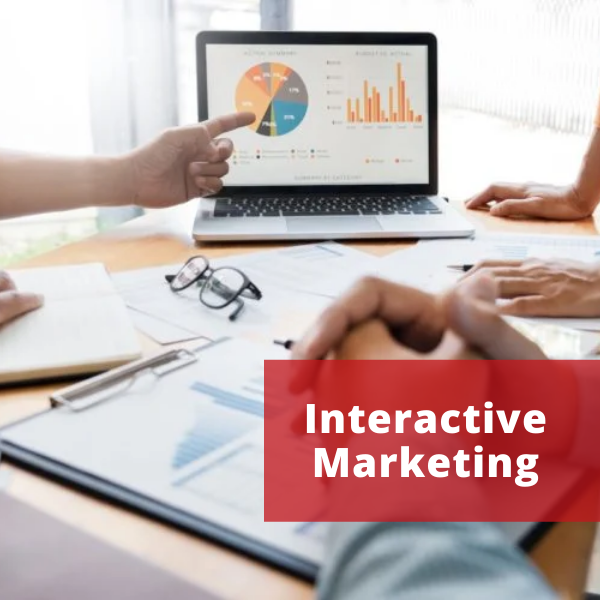Interactive marketing is a marketing strategy that allows consumers to connect with a company directly which increases the chance of meeting customer needs. The behavior of visitors to your website is collected and analyzed in interactive marketing. This can take various forms, but search engine marketing is one of the most frequent.
Simply said, when a client types a question or query into a search engine, the advertising that appears is directly related to that query. If someone searches for “excellent winter boots” on Google, for example, they are likely to get adverts on several sites based on their search criteria. This straightforward type of marketing unites items, services, and customers in a nutshell.
Your official company website, on the other hand, is a great place to start learning about interactive marketing. One of the most important instruments for consumer involvement in your website. Prospective clients are likely to land on your page because they’re interested in your products or services.
They’ll likely peruse your items and offerings, as well as interact with online forms or forums and investigate your company’s history. Customers’ interactions with your website will provide you with a plethora of data and insight into their habits. You’ll be able to see the most popular items, services, and pages, as well as the most visited, purchased, and therefore valuable.
Examples of Interactive Marketing
Amazon is one of the most well-known instances of a website that employs these strategies. Amazon collects user data and displays it to its consumers in a useful way. If you’ve ever used Amazon, you’ve probably noticed the “recommended reading” section, which suggests books based on your previous browsing history.
This form of marketing strategy emphasizes the personal purchasing experience by engaging the customer’s requirements and making them feel driven to spend more time on the website. As you might expect, the longer a buyer spends on a website, the more likely they are to make more purchases.
In addition, Amazon retains customer preferences and sends e-mails highlighting new or comparable items based on browsing history. All of these strategies work together to boost their conversion rate, which is exactly what any internet business wants, right?
Advantages of Interactive Marketing
As you may expect, interactive marketing has a slew of advantages that will have a direct and positive impact on your company. The following are some of the advantages:
Increased sales
Most businesses aim to improve their conversion rate, and for good reason. This is, fortunately for you, what interactive marketing accomplishes. It works to improve your chances of being able to supply what the consumer wants, as well as providing things that are linked to previous and current searches.
Lower prices than traditional marketing efforts
For starters, any sort of online advertising is substantially less expensive than traditional marketing efforts like television, print, and radio, and may frequently yield a far higher return rate.
Client satisfaction
As we all know, interactive marketing is all about meeting the needs of the customer. You’ll be able to match your customer with the proper product or service more often than not, resulting in more satisfaction with the least amount of work. Furthermore, a satisfied consumer is more likely to remain loyal than one who is unable to get what they require.
Disadvantages of interactive marketing
Interactive marketing, like any other marketing technique, involves careful planning and execution. Even if a system eventually records and decodes many factors for you, you’ll still need the tools to grasp what these numbers imply.
Comfort factor
Ads that are tailored to a customer’s goals and requirements might be scary or unsettling for certain people. Delivering recommendations entails keeping track of what your clients do, which might be unsettling for some. Ads directed at them may force them to distance themselves from your organization. However, many digitally savvy clients will be accustomed to it.
Customer differences
Customer probabilities are used in interactive marketing. However, just because a large number of people purchased both A and B does not guarantee that this will happen every time. Unfortunately, this can backfire in some circumstances, revealing that you don’t know your customer as well as you think.
It takes more than a few mouse clicks to implement interactive marketing in your company. It’s all about spending the time to learn about your market as well as your clients’ demands and needs.
Best Practices for Effective Interactive Marketing Campaigns
1. Identify your target market and segment your customers
The first step for any business is to create a clear image of their ideal customer. It is simple to segment current customers into distinct categories after a corporation determines who its product will be most relevant to. Not every audience will respond to every interactive marketing strategy. It’s easier to design a marketing campaign tailored to your buyers if you create thorough profiles for them. Creating compelling content is subjectively as much about the content you generate as it is about the material you create objectively.
2. Figure out which triggers work the best
A trigger campaign involves sending a message in response to a specified event. Trigger messages are an excellent approach to maintain a more natural interaction with the user. A welcome message may appear when you visit a website or download an app, for example. Other triggers could be sent after a certain amount of time has passed to urge people to return to the brands.
The route through which the trigger is communicated must be defined by the company. Some triggers, such as a security breach, should be Omnichannel because they are urgent. Your brand, on the other hand, risks upsetting clients if less relevant and urgent triggers are disseminated across several media.
3. Personalize your content
It is by far the most crucial tip, yet it is also the most evident. If you want to give your users a one-of-a-kind experience, you should tailor your interactive marketing efforts to them. It might be as basic as addressing customers by their first names in emails or text messages. Another fantastic method to make the most of the data you’ve gathered about your consumers is to send a tailored happy birthday message coupled with a contest or offer. Because content personalization is a data-driven process, you’ll want to make sure your database is as current as possible.
4. Create incentives for your customers
Why should a user connect with the content you provide? This question has a number of alternative responses. However, most responses are useless if the content you provide has no financial motivation. What good is a contest or giveaway if the reward isn’t worth anything? The reward you offer in exchange for your customer’s time and attention must be truly valuable. Such contests would be pointless if they were not organized and hosted. It, too, can give you a lot of information about your customers’ habits. Which customer is more interested in which prize? This question reveals a lot about a person’s interests and tastes.
5. Make the most out of modern technology
In the first place, modern technology allowed marketers to collect so much information on their clients. It takes a lot of effort to collect data on consumers. Technology has made it possible to personalize interactive marketing while also giving mass marketing the perception of interactivity. Various tools can be used to leverage technology to scale your personalization approach, such as:
• Data Visualization Tools– Infographics have grown in popularity and are simple to make with these tools.
• Chatbots– Chatbots are a terrific way to communicate with clients and answer common queries without having to repeat the same information over and over again.
• Virtual Reality– Augmented reality produces an interactive environment that’s ideal for exhibiting products and services in a virtual world.
• Interactive Videos– As previously said, interactive videos hold the audience’s attention while allowing them to follow instructions at their own pace. It’s a fantastic and clever marketing tool that’s also quite user-friendly.
Final Words
Most importantly, it helps customers feel more connected with your brands and that is the essence of interactive marketing. It is clear that interactive marketing is effective in letting audiences interact with your marketing content. Digital Marketing Company in Chennai offers interactive marketing and you can consult them for any queries.

